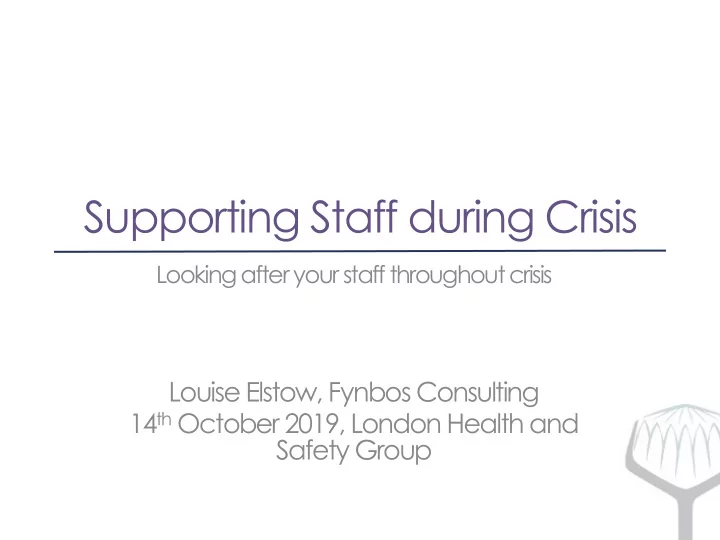

Supporting Staff during Crisis Looking after your staff throughout crisis Louise Elstow, Fynbos Consulting 14 th October 2019, London Health and Safety Group
Intro • Tend to focus on front line staff from emergency services • Be prepared to look after staff welfare before, during and after an emergency/crisis • Considering staff welfare throughout the whole emergency/crisis management cycle
Emergency/Crisis Management Cycle Anticipate Horizon scanning for potential Recover emergencies New normal, incorporating lessons Assess Prevention/ Threat / Recovery impact / risk Mitigation Response Preparation Respond Prevent Act- emergency Reduce likelihood of response/ BCM event happening. (plant recovery) Control measures / security Prepare Develop plans, training, mitigation of effects
Staff support includes Not just physical health and Also takes into account: safety of responders: • Emotional support • Absence or minimising • Mental wellbeing potential physical harm • Considering other external • Risk assessments factors (e.g. family • Breaks / time off / circumstance, health) refreshments • Communication • Practical support • Making sense of what has • Etc….. happened
Which staff? Who are we talking about? Swat emergency response team • Only those on duty rotas • Volunteers (outside their normal • role) Other organisations or individuals • Whole organisation • How have you identified them? • Do they know who they are? • What is expected of them?....... Are they practically and • emotionally prepared?
Preparation Planning Involve as many people as • possible in the plan –not just the planners Potential mindsetdifference • between Cat 1/2 responders and other organisations who may not expect to respond Identify best roles to suit • existing skills and knowledge Risk assessments for the likely • tasks and locations of work Work with line management • Photo credits: Yashima, Creative Commons License
Preparation Training and Exercising Training Exercising • • – all people involved who might – in line with response responsibilities have to respond –not just (be realistic) planners – Training needs to be regular and – Type of exercise suitable for their appropriate to role training and role – Incorporate flexibility and – Live -most likely to replicate the adaptability as the plan always stress that they might be under falls at first sight of the enemy! – Active learning after exercises
What about you In small groups or with the person next to you, discuss (5 mins): • What kinds of crises does your organisation plan for? • What does preparation look like? • As health and safety individuals – are you part of planning/preparation in your organisation?
Response Adequate protection from physical • hazards on site External factors at thattime (e.g. • family, health etc) Physical / practical/ emotional • support from others – Shift lengths/ patterns/ frequency – Rest and breaks –for refreshment and being off duty (from being responsible) – Accommodation (people away from home comforts) – Transport to and from response – Buddy system? Hot debriefs –operational and • Not my pic! emotional aspect
How might your staff react? How might they behave? What emotions might they Potential display? Reactions How might they think? What physical signs might show?
How many did you get? Physical Emotional anger elevated blood pressure apprehension chills fear rapid heart rate emotional shock thirst guilt muscle tremors emotional outbursts fatigue shock symptoms grief feeling overwhelmed twitches teeth grinding panic loss of emotional vomiting visual difficulties denial control dizziness sweating anxiety Inappropriate weakness difficulty breathing emotional response agitation chest pain Stomach ache irritability headaches sadness Cognitive poor abstract thinking Behavioural poor attention/memory hyperalertness to disorientation withdrawal environment confusion heightened or lowered inability to rest increased alcohol nightmares alertness pacing consumption uncertainty increased or hypervigilance change in social change in usual decreased awareness activity communications suspiciousness of surroundings loss or increase of intrusive images appetite blaming someone poor problem solving
Recovery Immediate Longer term • Debriefs: • Post incident reports – Cold debrief • Learning from crises – – Structured debriefs ‘lessons learned vs identified’ • Time off afterwards • Inquiry – moving on/ • Phased return to ‘normal closure or not? duties’ • Recognition for efforts • Briefing colleagues • Memorials and reminders? • OH/ TRiM/EA Programmes • Monitoring and signposting • Leaflet to additional NHS services • Performance targets?
Looking after your people Staff welfare does not begin • and end during response There is a lot to be done in • advancebefore anything actually happens Equally, just ensuring that there is • an employee assistance programme in place may not be the end of it…..
Any questions? Louise Elstow Emergency Management Consultant Fynbos ConsultingLimited Louise.elstow@fynboslimited.co.uk 07810 433 181
Recommend
More recommend